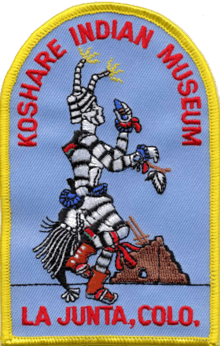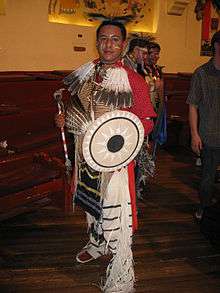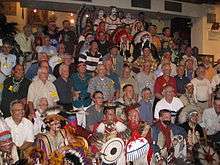Koshare Indian Museum and Dancers
 | |
| Coordinates | 37°58′19″N 103°32′40″W / 37.97190°N 103.54456°WCoordinates: 37°58′19″N 103°32′40″W / 37.97190°N 103.54456°W |
|---|---|
| Website |
www |
The Koshare Indian Museum is a registered site of the Colorado Historical Society in La Junta, Colorado.[1] The building, located on the Otero Junior College campus, is a tri-level museum with an attached kiva that is built with the largest self-supporting log roof in the world.[2] The building was built in 1949.[3]
The museum features works of Pueblo and Plains tribal members.[4]
The museum also facilitates Boy Scouts traveling to Philmont Ranch by providing museum discounts, as well as hostel stays for visiting Boy Scout troops.[5]
Koshare Indian Dancers
| Koshare Indian Dancers | |||
|---|---|---|---|
| Headquarters | La Junta, Colorado | ||
| Founded | 1933 | ||
| Founder | James F. "Buck" Burshears | ||
| Affiliation | Boy Scouts of America | ||
|
| |||
|
Website www | |||
Koshare Indian Dancers are members of Boy Scout Troop 232 in the Rocky Mountain Council of the Boy Scouts of America, located in La Junta, Colorado. They have been performing their interpretations of Native American dance since 1933.[6] In addition to participating in regular Scouting activities, such as camping, merit badge projects, and community service, Koshares create a dance outfit, including leatherwork and beading, based upon their own historical research. They travel around the country and perform traditional Plains and Pueblo Native American ceremonial dances.[7] They also perform 50–60 Summer and Winter Ceremonial shows, annually,[8] at their kiva located at the Koshare Indian Museum in La Junta. The Koshares have performed in 47 states.[9] A few Native Americans including two tribal leaders who have witnessed or otherwise been made aware of the performances have stated that they are an offensive form of cultural appropriation.

History
Founded by Scoutmaster and author of "The Scoutmaster's Prayer" James F. "Buck" Burshears (1909–1987) in February 1933[10] the Koshares, originally called the Boy Scout Indian Club, first practiced in Burshears's backyard and chicken coop. Their name was subsequently changed to Koshare, meaning clown or "delight-maker" in the Hopi language, as Burshears thought the name appropriate for the early members of the troop. Bill Sisson and Bob Inman, the first two Koshare Scouts, expanded Boy Scout Troop 232[11] to include eighteen other Scouts.[12] Their first performance took place in September 1933, at St. Andrew's Episcopal Church in La Junta, Colorado.[8]
I have been to many spectacles, from Madison Square Garden and the New Amsterdam Theatre to the Hollywood Bowl and the Santa Anita race track, and there is nothing in my memory to match a performance of these Boy Scouts which was recently given at the Red Rock Theatre, up in the hills from Denver.
Be a Great Boy is a compilation of memoirs from past Koshare Indian Dancers. The book also serves as an archive of the museum's history and media coverage.[13]
Koshare ranks

In addition to fulfilling Boy Scout requirements, members dedicate additional time to learn Native American culture, ceremonial dances and recreate Native American regalia. Koshares may increase their ranks within their individual tribes by completing various Scouting activities and fulfilling rank-specific requirements. The three different tribes whose dance styles are represented include the Kiowa, Sioux, and the Navajo.[6]
New members are called Papooses. They must be at least 11 years old, but no older than 18 or have earned an Arrow of Light Award, which is the highest Cub Scout award.[14]
After having obtained their Star Scout Rank, they may work towards the status of Koshare Brave. In order to become a Brave, the Scout must maintain a "C" average in school, earn the Indian Lore Merit Badge, be well practiced in five Koshare Indian dances, exemplify good Scout attitude, read five books about Native American culture, create a well researched outfit, and be elected by current Koshare members.
Following the rank of Brave, a Scout may become a Clan Chief, with one Chief for each of the three tribes, after attaining their Eagle Scout. Additionally, each year one Eagle Scout is elected to be the Head Chief and is responsible for leading all members.[8]
The Clowns, painted in black and white, intercede between dances to provide comic relief, by taunting the crowd and mimicking the dancers. In the Pueblo culture, the clowns, or koshare, help to depict unacceptable behavior and teach values.[15]
In 1995, in an attempt to make the dances more accurate, two girls were allowed to perform with the Koshares each year. Thanks to its success, in 2003, girls were invited to join the performances, regularly, and the "maiden program" was created.[8]
75th anniversary

On July 25, 2008 the Koshares celebrated their 75th anniversary with a reunion at the kiva.[16] All former members were invited to join with the current members in an evening performance. The two original members, Bill Sisson and Bob Inman were in attendance along with hundreds of current and former members.[17]
Native American responses
In chapter four of his book Playing Indian, Native American historian Philip J. Deloria refers to the Koshare Indian Museum and Dancers as an example of "object hobbyists" who adopt the material culture of indigenous peoples of the past ("the vanishing Indian") while failing to engage with contemporary native peoples.[18][19] Some Native Americans have stated that all such impersonations and performances are a form of cultural appropriation which place dance and costumes in an inappropriate context devoid of their true meaning, sometimes mixing elements from different tribes.[20]
For 2015, the Winter Night dances were canceled after a request was received from Cultural Preservation Office (CPO) of the Hopi Nation asking that the troop discontinue their interpretation of the dances of the Hopi and Pueblo Native Americans.[21] When Leigh Kuwanwisiwma, the director of the CPO learned recently about the program and saw video online of some of the performances, he was disturbed. The performers, he said, were “mimicking our dances, but they were insensitive, as far as I’m concerned.”[22] However, great offense was taken by the head councilman of the Zuni Pueblo upon witnessing a performance in the 1950s. “We know your hearts are good,” he said, “but even with good hearts you have done a bad thing.” In Zuni culture religious objects and practices are only for those that have earned the right to participate, following techniques and prayers that have been handed down for generations.[23]
See also
References
- ↑ "Otero County - History Colorado". Retrieved December 22, 2015.
- ↑ "Otero Junior College". Ojc.edu. Retrieved July 28, 2010.
- ↑ http://www.kosharehistory.org/history.html Archived September 18, 2008, at the Wayback Machine.
- ↑ "Koshare Indian Museum and Kiva - Museum Review in La Junta at Frommer's". Frommers.com. Retrieved July 28, 2010.
- ↑ http://kosharehistory.org/koshare/scouts.html Archived September 19, 2008, at the Wayback Machine.
- 1 2 Daily, Laura (May 1998). "Dances with Scouts". Boy's Life. p. 16.
- ↑ Sarlo, Susie. "Award for Excellence" (PDF). Retrieved November 29, 2009.
- 1 2 3 4 "Koshare Dancers". Visit La Junta. 2009. Archived from the original on September 20, 2010. Retrieved November 29, 2009.
- ↑ "Koshare History". Koshare Indian Museum. Retrieved November 29, 2009.
- ↑ "The Scoutmaster's Prayer". Archived from the original on July 5, 2008. Retrieved May 6, 2009.
- ↑ "Overview of the Koshare Indian Dancers". Archived from the original on September 18, 2008. Retrieved May 6, 2009.
- ↑ "1933". Retrieved November 27, 2009.
- ↑ "Home". Beagreatboy.com. Retrieved July 28, 2010.
- ↑ "Boy Scouts of America:The Achievement Trail". Boys Scouts of America. Retrieved January 5, 2006.
- ↑ "Koshare Indian Kiva Museum". Koshare Indian Kiva. Retrieved December 6, 2009.
- ↑ Justice, Jennifer (29 December 2008). "Koshares celebrate successful year, 75th anniversary". La Junta Tribune-Democrat. La Junta, Colorado. Archived from the original on February 27, 2012. Retrieved January 5, 2016.
- ↑ Deloria, Philip J. (1998). Playing Indian. New Haven: Yale University Press.
- ↑ "Playing Indian". Yale University Press. Retrieved January 6, 2016.
- ↑ Robert Desjarlait (December 15, 2015). "The Koshares and the Appropriation of Native American Dance".
- ↑ "Koshare Museum". Retrieved December 22, 2015.
- ↑ Anne Constable (January 3, 2016). "Hopis say Boy Scout performances make mockery of tradition, religion". Santa Fe New Mexican.
- ↑ Kristen Dobbin (September 10, 2014). "Appropriation (?) of the Month: The Boy Scout Shalako".
Further reading
- Balicki, David. Be a Great Boy. United States:Lulu, 2009.
- Gendron, Val. Behind the Zuni Masks. United States:Longman, 1958.
- Kelly, Jack. Koshare. n.d.:Pruett Pub., 1975.
External links
![]() Media related to Koshare Indian Museum at Wikimedia Commons
Media related to Koshare Indian Museum at Wikimedia Commons